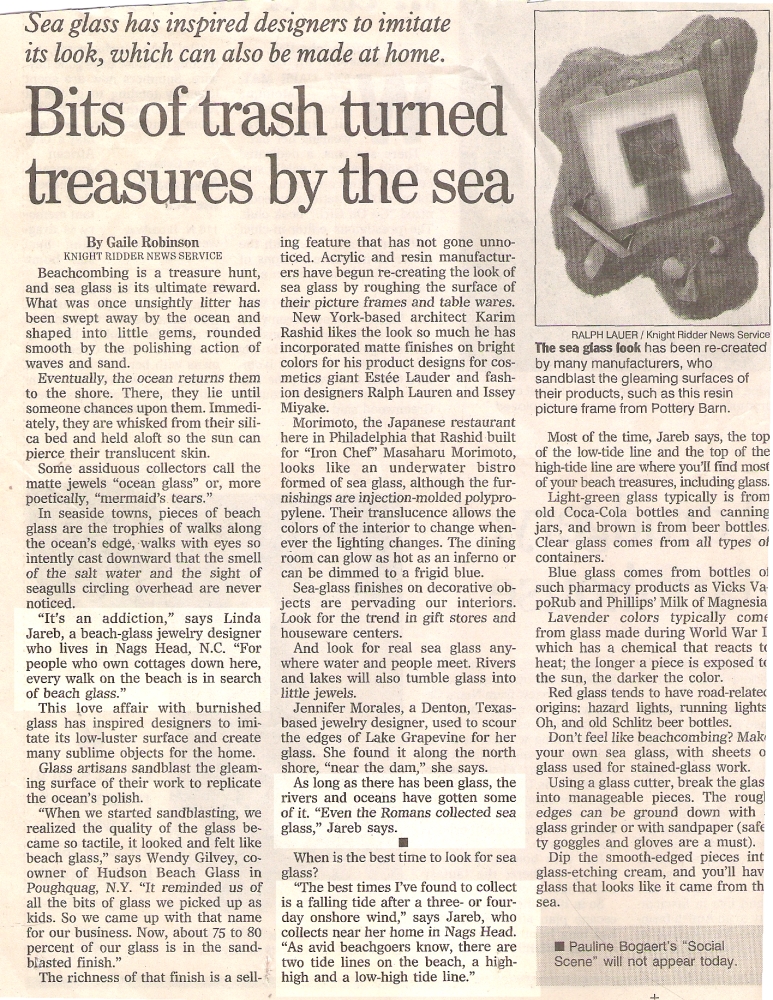Bits Of Trash Turned Treasures By The Sea
Sea Glass has inspired designers to imitate it's look, which can also be made at home.
Bits of trash turned treasures by the sea.
By Gaile Robinson.
Knight Rider News Service.
Beachcombing is a treasure hunt, and sea glass is its ultimate reward. What was once unsightly litter has been swept away by the ocean and shaped into little gems, rounded smooth bu the polishing action of waves and sand.
Eventually, the ocean returns them to the shore. There, the lite until someone changes upon them. Immediately they are whisked from their silica bed and held aloft so the sun can pierce their translucent skin.
Some assiduous collectors call the matte jewelry "ocean glass" or, more poetically, "mermaids tears".
In seaside towns, pieces of beach glass are the trophies of walks along the oceans edge, walks with eyes to intently cast downward that the smell of the salt water and sight of seagulls circling overhear are never noticed.
"It's and addictions" says Linda Jareb (sp.Jereb), a beach glass jewelry designer who lives in Nags Head, NC. "For people who own cottages down here, every walk on the beach is in the search of beach glass".
This love affair with burnished glass has inspired designers to imitate its low-luster surface and create many sublime object for the home.
Glass artisans sandblast the gleaming surface of their work to replicate the ocean's polish.
"When we started sandblasting, we realized the quality of the glass became tactile, it looked and felt like beach glass", says Wendy Gilvey, co-owner of Hudson Beach Glass in Poughaquag, NY. "It reminded us of all the bits of glass we picked up as kids. So we came up with that mane for our business. Now, about 75 to 80 percent of our glass is in the sandblasted finish".
The richness of that finish is a selling feature that has not gone unnoticed. Acrylic and resin manufacturers have begun re-creating the look of sea glass by roughing the surface of their picture frames and tableware's.
New York based architect Karim Rashid like the look so much he has incorporated matte finished on bright colors for his product designs for cosmetics giant Estee Lauder and fashion designers Ralph Lauren and Issey Miyake.
Morimoto, the Japanese restaurant here in Philadelphia that Rashid built for "Iron Chef" Masaharu Morimoto, looks like an underwater bistro formed of sea glass, although the furnishings are injection molded polypropylene. Their translucence allows the colors of the interior to change when ever the lighting changes. The dining room can glow as hot as an inferno or can me dimmed to a frigid blue.
And look for real sea glass anywhere water and people meet. Rivers and lakes will also tumble glass into little jewels.
Jennifer Morales, a Denton Texas based jewelry designer, used to scour the edges of Lake Grapevine for her glass. She found it along the north shore "near the dam" she says.
As long as there has been glass, the rivers and ocean have gotten some of it. "Even the Romans collected sea glass." Jereb says.
When is the best time to look for sea glass?
"The best times I've found to collect is a falling tide after a three or four day onshore wind," says Jereb, who collects near her home in Nags Head. "As avid beach-goers know, there are two tide lines on the beach, a high-high and a low-high tide line".
Most of the time, Jereb says the top of the low-tide line are where you'll find most your beach treasures, including glass.
Light green glass is typically from Coca-Cola bottles and canning jars, and brown is from beer bottles. Clear glass comes from all types of containers.
Blue glass comes from bottles of such pharmacy products as Vick's Vapor Rub and Phillips Milk of Magnesia.
Lavender colors typically come from glass made during the World War I which has a chemical that reacts to heat; the longer the piece is exposed to sun, the darker the color.
Red glass tends to have road related origins; hazard lights, running lights, Oh and old Schlitz beer bottles.
Don't feel like beachcombing? Make your own sea glass with sheets of glass used for stained glass work.
Using a glass cutter, break the glass into manageable pieces. The rough edges can be ground down with a glass grinder or with sandpaper (safety goggles and gloves are a must).
Dip the smooth edged pieces into glass etching cream, and you'll have glass that looks like it came from the sea.

